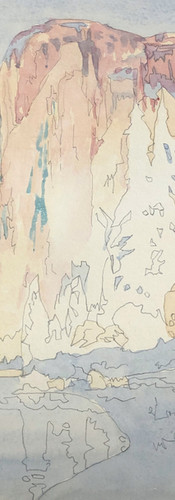The wonderful world of woodblock
- Tracey Bengeyfield

- 2 days ago
- 2 min read

In this Artist Master class we will discover the beautiful work of Japanese woodblock artist Yoshida Hiroshi. Yoshida brought western ideas together with traditional Japanese Woodblock techniques to create a modern Ukiyo-e style which although 100 years old still has a fresh, contemporary feel.
This woodblock print has 6 layers and was created using 33 impressions. Each colour block is layered on top which alters the hue and value of the colours. This idea is similar to how watercolour artists use the glazing technique - where one colour is layer over the top of a dried colour. It is this technique which we will use to create our version of El Capitan.
Once the line drawing is complete we will mix the palest colour of the mountain and give our painting a flat wash. A flat wash is one of the key watercolour skills so it’s a great opportunity to get to grips with this technique.

The flat wash technique takes time to perfect ~ but the key things to remember are:
Tilt your paper at an angle
Keep your brush full of paint ~ with no rinsing out between strokes
Keep the paint moving
Keep your brush strokes in the same direction
Don’t try to go back and ‘fix’ things as you go
If the wash isn’t as successful as you hoped let it dry completely. Then use a large wet brush to blend away any problem areas - trying to do this part way through whilst the paint is still wet will create more issues!
To achieve the right style, we will add colour in layers - just like a woodblock. We will layer paint over dry colour, working from light to dark. Where two colours overlap new colours will be created.
Looking at the colour palette of other artists is a really good way to learn about colour and mixing techniques. The process of mixing colours to match an existing artwork helps you to identify colours and think about their colour bias, temperature and value. I will show you how to identify the warm and cool colours which will help you to know where to start. Colour matching will also help you to get to know your own paints better and make colour mixing quicker and easier.

Once your colours are layered you will use a fine line pen or a colour pencil to add the outline details which gives it a typical woodblock feel.
If you would like to find out more about this tutorial, take a look at the short video below:
If you like the idea of layering colour in this way - or if you want to try your hand at this technique but using a different style ~ you might like to try my Cezanne Artist master class which uses similar colours and techniques.
Happy painting!










Comments